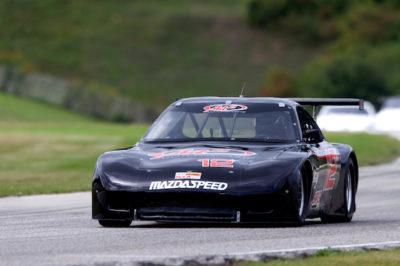You can make your car quieter without losing horsepower.
There is nothing quite like the sound of a rotary at full song. It’s the sort of thing that makes a gearhead’s heart flutter. Unfortunately not everyone responds to the noise the same way, which is why sound limits at racetracks are here to stay.
Mazda Raceway Laguna Seca has some of the toughest sound limits in the country. Those coming from places and home tracks where they are easily under the limit may find that they struggle with sound at Mazda Raceway. Many other tracks are adopting similar restrictions. Fortunately, it’s not too difficult to fix, even for a GT-class-prepared 13B.
The first thing to know is that sound control at Mazda Raceway is at driver’s right between Turns 5 and 6, right where the car will be at full throttle as it heads up the hill. So if your exhaust exits on the passenger side of the car, the first thing you’ll want to do is point it the other direction. When Dave Steele was working on that task for Southern California GT-3 RX-7 racer Mike Henderson, he found a few other things that brought sound down significantly without reducing power,
Steele has worked at every level from club racing to the American Le Mans Series, including making sure Mike Lewis had an RX-7 he could drive to a trio of GT-3 National Championships in the 1990s. Now he works on Henderson’s car as Henderson attempts his own National Championship.
“In the midst of [relocating the exhaust exit] I just kept my standard short exhaust system – which is what a lot of people do on rotaries, a short header coming out the passenger door,” explains Steele. “We put two four-inch Borlas at the back of the car, back-to-back Borlas in the rear bumper area. That was pretty tremendous. It didn’t really hurt the horsepower, didn’t really gain any horsepower; but the sound level dropped tremendously.”
Then he tried putting a third muffler, a Mazda Comp unit stuffed with lava rocks that can withstand the heat of a rotary, which is no longer available. That one may have been unnecessary to meet sound, Steele says, but not only did it make the car even quieter, it actually picked up a couple of horsepower and some torque.
“Just the two Borlas alone, I’m 99 percent sure you’d make sound with no problem; it’s so quiet it’s not even funny. It’s almost like a street car now. All this was done on the chassis dyno I always run on. We started with our normal exhaust system and got our baseline run in with that and started adding stuff.”
The exhaust system is still short, at least before it gets to the mufflers – only about 18 inches long before it starts hitting the sound control devices. But most importantly, it’s quiet AND effective.
“It was a lot of luck that we made a really quiet car that produced more horsepower,” Steele says.


 ACCESSIBILITY
ACCESSIBILITY